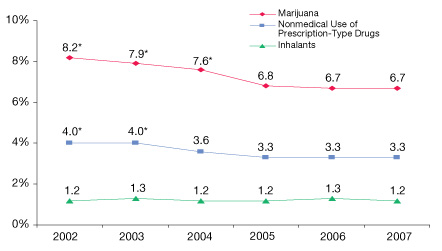Youth & Substance Abuse: 5-Year Trends
Young people are improving in their efforts to stay away from drugs, alcohol, and cigarettes.
A recent report from SAMHSA shows past-month use of cigarettes, alcohol, and illicit drugs declined among adolescents (youth age 12 to 17) between 2002 and 2007.
Rates of past-year dependence on or abuse of illicit drugs also declined in this age group. The rate of alcohol dependence or abuse among this age group in 2007, however, did not differ significantly from the rate in 2002.
These data are included in SAMHSA’s National Survey on Drug Use and Health (NSDUH) report, Trends in Substance Use, Dependence or Abuse, and Treatment among Adolescents: 2002 to 2007.
Between 2002 to 2007, adolescents’ past-month use of cigarettes declined from 13.0 to 9.8 percent, past-month use of alcohol declined from 17.6 percent to 15.9 percent, and past-month use of illicit drugs declined from 11.6 to 9.5 percent (see chart).
The decline in past-month illicit drug use can be attributed primarily to a decline in marijuana use, with 8.2 percent of adolescents using the drug in 2002 compared with 6.7 percent in 2007.
The two other most common illicit drug categories used by adolescents are inhalants and the nonmedical use of prescription-type drugs. Between 2002 and 2007, use of inhalants remained stable at 1.2 percent, while the nonmedical use of prescription-type drugs declined from 4.0 to 3.3 percent.
Past-year dependence on or abuse of illicit drugs among adolescents declined from 5.6 percent in 2002 to 4.3 percent in 2007. The rate of alcohol dependence or abuse in 2007 (5.4 percent) did not differ significantly from the rate in 2002 (5.9 percent), although it was significantly lower than the rate in 2004 (6.0 percent).
Substance dependence or abuse is defined based on criteria in the American Psychiatric Association’s Diagnostic and Statistical Manual Fourth Edition (DSM-IV). The criteria include symptoms such as withdrawal, tolerance, use in dangerous situations, trouble with the law, and interference in major obligations at work, school, or home during the past year.
Read the full report in PDF or HTML format on SAMHSA’s Web site.
Enlarge image
 Source: SAMHSA, Office of Applied Studies. (December 4, 2008). The NSDUH Report: Trends.
Text only
Source: SAMHSA, Office of Applied Studies. (December 4, 2008). The NSDUH Report: Trends.
Text only
Parent Awareness of Youth Substance Use Varies, July/August 2008
Decline in Illicit Drug Use by 8th Graders, January/February 2008
Adolescents Do What Every Day? November/December 2007
Reach Out Now: Start Talking Before They Start Drinking, March/April 2007.